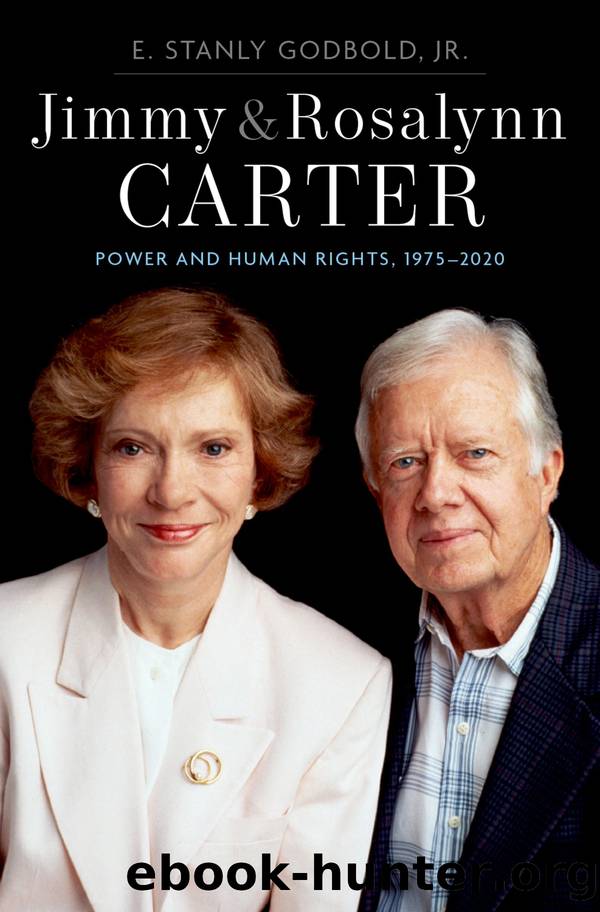Jimmy and Rosalynn Carter by E. Stanly Godbold Jr

Author:E. Stanly Godbold, Jr.
Language: eng
Format: epub
Publisher: Oxford University Press
Published: 2022-03-15T00:00:00+00:00
Thirty Three
The Agony of Defeat
In the seclusion of Hickory Lodge at Camp David, with Rosalynn intently observing, Carter laboriously rehearsed for his debate with Reagan. To play the role of Reagan, Pat Caddell had chosen his friend Sam Popkin. Popkin, a political science professor from California, set up a podium, lights, and every other detail exactly like they would be in the auditorium where Carter would face Reagan on October 28. Popkin, in his late thirties, rumpled and wearing glasses, did not look like Reagan, but he had studied Reagan carefully and determined that Reagan had no more than twenty or thirty set paragraphs. Popkin did not try to imitate Reagan the genial guy, but he concentrated on what Reagan would say and how he would say it. Privately, Popkin later confessed that it had been emotionally draining to look the president in the eye, tell him he had failed, brought the United States to its knees, and humiliated the country. Nervous not only because Rosalynn was watching, but also because he wondered if the Secret Service guards might hit him âin the knee,â Popkin nevertheless led the president through several intense rehearsal sessions.
A good student, Carter improved with practice, but he had a hard time refraining from interrupting, keeping his composure, and not revealing his anger. He mastered the lesson, however, and was prepared to keep calm and focused during the debate. His tutor noted that by the end of the grueling sessions, Carter was âhandling thingsâ well, as âyou would expect from a man of that intelligence and demeanor.â Adept at defending his record, Carter thought he was ready to debate Reagan in Cleveland.1
On the eve of the debate, October 25, the polls showed Carter leading Reagan by 45% to 42%, but a third party candidate, John B. Anderson, claimed 8% of those polled.2 Refusing to leave the race, Anderson organized the independent National Unity Party, chose a Democrat, the popular former Democratic governor of Wisconsin and former ambassador to Mexico Patrick Lucey as his running mate, and developed a platform that favored support for research in universities, environmental protection, ratification of the ERA, and a womanâs right to have an abortion. He opposed Carterâs reinstatement of the military draft, but he strongly supported US military strength and the NATO alliance against the Soviet Union.3 The son of an immigrant father who had been willing to make sacrifices in order to give his family a better future, Anderson appealed to moderate âRockefellerâ Republicans and liberal Democrats, especially college students, who had supported Ted Kennedy.
In early September, the League of Women Voters, which determined the eligibility of candidates to participate in debates, decided that Anderson was qualified. Carter refused to debate him, because he found it difficult to take his candidacy seriously. Reagan did debate Anderson in Baltimore on September 21, an event Carter found âreally depressing,â because Anderson âhelped himself with liberalsâ while Reagan seemed to be âineffectual.â4 By early October, Andersonâs following declined but still remained numerous enough that he might be a spoiler in a tight race between Reagan and Carter.
Download
This site does not store any files on its server. We only index and link to content provided by other sites. Please contact the content providers to delete copyright contents if any and email us, we'll remove relevant links or contents immediately.
| U.K. Prime Ministers | U.S. Presidents |
Waking Up in Heaven: A True Story of Brokenness, Heaven, and Life Again by McVea Crystal & Tresniowski Alex(37490)
Empire of the Sikhs by Patwant Singh(22767)
We're Going to Need More Wine by Gabrielle Union(18633)
Hans Sturm: A Soldier's Odyssey on the Eastern Front by Gordon Williamson(18328)
Leonardo da Vinci by Walter Isaacson(12804)
The Radium Girls by Kate Moore(11621)
Tools of Titans by Timothy Ferriss(7815)
Educated by Tara Westover(7690)
How to Be a Bawse: A Guide to Conquering Life by Lilly Singh(7156)
Permanent Record by Edward Snowden(5541)
The Last Black Unicorn by Tiffany Haddish(5414)
The Rise and Fall of Senator Joe McCarthy by James Cross Giblin(5150)
Promise Me, Dad by Joe Biden(4909)
The Wind in My Hair by Masih Alinejad(4844)
The Crown by Robert Lacey(4573)
A Higher Loyalty: Truth, Lies, and Leadership by James Comey(4552)
The Iron Duke by The Iron Duke(4122)
Joan of Arc by Mary Gordon(3784)
Stalin by Stephen Kotkin(3725)
